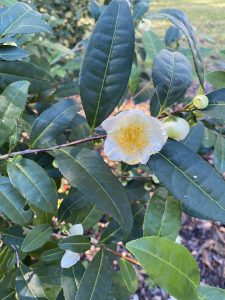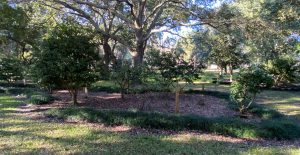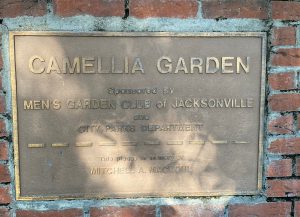If there was ever a plant that was considered royalty in southern landscapes the camellias would undoubtedly be it. They have been grown in our gardens for over 200 years. With origins in Asia, it is thought that there are over 20,000 varieties of camellias grown throughout the world. In the Shinto religion, it is said when the gods came to visit earth, they made camellia flowers their home. Interestingly, most popular camellia in the world is not known for its flowers but for its leaves. Camellia sinensis is the plant whose leaves are harvested for the caffeinated green and black tea beverage.

Photo Credit: Larry Figart UF/IFAS
There are over 2,300 named camellia cultivars registered with the American Camellia Society. The camellias we grow in the landscape in Florida are typically Camellia japonica, Camellia sasanqua, and their varieties, and hybrids. Camellia japonica cultivars and hybrids are the most common camellias we see in North Florida because of the availability of unique plants. These broadleaved evergreen shrubs usually reach a mature size of 6-12 feet with a spread of 6-10 feet and typically have the more stunning blooms.

Camellia sasanqua plants are typically smaller at 1 ½ – 6 feet in height. They typically tolerate sunnier sites. The leaves are darker green and smaller as well. The blooms are usually smaller, but fragrant and more abundant.
Camellias are usually planted in groups or in mass plantings rather then by themselves. Unfortunately, they require a precise arrangement of conditions in order to grow well. They do best when planted under filtered/ shifting sunlight in soil with a high amount of organic matter. They require a slightly acidic soil with a pH between 5.5 and 6. They need a well-drained but moist soil, so do not plant them in sites with high water tables and poorly drained soils. Japonica varieties should be spaced about 10 feet apart and sasanqua varieties can be spaced 5-6 feet apart.
Camellias do not tolerate being planted too deep. When planting, the “plant them high and they won’t die” adage fits very well. The rootball should be 1- 2 inches higher than the surrounding soil after planting. Late fall through mid- winter is the best time to plant camellias for two reasons. First, they may still be in bloom so you can select the variety you like based on the flowers. Second, they will have time to become established before the heat of summer. An organic, fine pine bark, oak leaf, or pine straw mulch will help keep the soil under the plant cool and most while adding organic matter as it decomposes. When adding mulch keep it away from the base of the plant to prevent basal rot.
Camellia fertilization usually includes 1-3 applications of fertilizer a year. If they are established and planted in the ground an “acid forming” fertilizer typically labeled for azaleas and camellias can be used. A fertilizer containing equal percentages of nitrogen and potassium (first and third numbers on the bag) and little or no phosphorus is best used in early spring, and early summer. In early fall a third application with little or no nitrogen can be applied.
Camellias do not need regular pruning. Allowing them to grow to their natural form is best. As they mature, thin out some of the interior of the canopy using selective reduction cuts to allow for adequate air circulation and allow a little light to reach the interior of the plant. This will prevent a common problem in mature camellias which is dieback in the canopy of older plants.
Camellia fanciers are known to be very serious about their plants. Many have developed quite extensive plant collections. Fortunately, here are several interesting collections/ gardens within a few hours drive where you can see them in full bloom this winter.
- The Massee Lane Camellia Gardens are located at the American Camellia Society Headquarters in Fort Valley Georgia. They are open to the public with an admission fee.
- The Leu Gardens in Orlando contain the collections of Harry and Mary Jane Leu who travelled the world in search of rare camellias. There are over 1,500 camellia plants in the garden. It is open to the public from 9-5 with an admission fee.
- In Charleston South Carolina there are reportedly at least 20,000 camellia plants growing in the Magnolia Plantation and Gardens. They have focused on collecting heirloom varieties dating prior to 1900. Entrance to the garden requires an admission fee.
In Jacksonville, we have the historic camellia gardens at Riverside Park. The Riverside Park camellia garden was created in February 1968 by members of the Men’s Garden Club of Jacksonville after a visit to the gardens of Mr. Frank Bisbee near the Trout River. Mr. Bisbee had over 1000 camellias in his garden. This visit sparked the dream of a large public camellia garden for Jacksonville. Today the camellia garden has over 80 camellia plants in several beds. A few dedicated members of the Men’s Garden Club of Jacksonville maintain the camellia plants by pruning, weeding and occasionally planting new plants as older ones fade. The Riverside Park camellia gardens are in the northeast corner of Riverside Park near the intersection of Park Street and Riverside Park Place. The information on the history of the Riverside Park Camellia Gardens was taken from “HISTORY OF THE CAMELLIA CARDEN RIVERSIDE PARK” compiled by John Searcy.
For more information on camellias including recommended varieties, go to “Camellias at a Glance” at https://edis.ifas.ufl.edu/publication/EP002. In addition, descriptions of other camellia varieties may be found at the American Camellia Society website: www.americancamellias.org.



Photo Credit: Larry Figart UF/IFAS
 0
0
